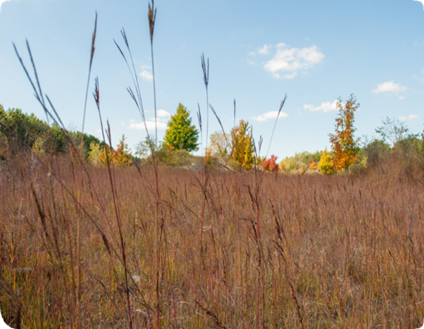At first glance, a sand or gravel pit may not seem a likely place to find innovation in biodiversity. But look beyond the piles of sand and stone, and you’ll soon discover the enormous care Ontario’s aggregate producers take to ensure biodiversity.
As stewards of Ontario’s aggregate resources (stone, sand and gravel), aggregate producers work hard to be good neighbours and land stewards by implementing conservation and stewardship activities on the landscape. In recognition of the efforts that producers do make towards biodiversity enhancement the Ontario Stone, Sand & Gravel Association (OSSGA) developed and launched a Biodiversity Award program which recognizes “achievement and innovation in biodiversity conservation.”1 The award recognizes OSSGA members for their contribution to sustaining biodiversity through species protection, habitat improvement and sustainable land use activities, and for conserving biodiversity in a way that goes well beyond regulatory standard practices and typical activities undertaken by the industry. It is also intended to raise public awareness of the positive impact the aggregate industry can have on Ontario’s biodiversity through responsible land stewardship and sustainable resource use.
Ontario’s Biodiversity Strategy, 2011 was central to the development of the award criteria. Each eligible project must demonstrate support of one or more of the following strategic directions:
• Engaging People;
• Reducing Threats;
• Enhancing Resilience; and
• Improving Knowledge.
Entries are judged by members of provincial environmental non-government organizations (ENGOs) including members of the Ontario Biodiversity Council.
OSSGA’s inaugural Biodiversity Award was presented in February 2015 to Dufferin Aggregates, a Division of Holcim (Canada) Inc. for their Biodiversity Indicator and Reporting System (BIRS) pilot project. The BIRS was developed by the International Union for Conservation of Nature (IUCN) in partnership with Holcim.
The BIRS was designed as a simplified scientific tool for monitoring biodiversity by assessing the condition and extent of habitats at an extraction site using ecological features within habitats as key performance indicators (KPIs) of the level of biodiversity. The BIRS allows a company to establish a baseline biodiversity level at a site and then use this to measure how operations are affecting habitats each year. The system also helps sites determine the effectiveness of both biodiversity mitigation and quarry/pit rehabilitation measures.
OSSGA’s member aggregate producers have a productive history of partnering with community groups and Non-Governmental Organizations to ensure the protection and/or revitalization of species at risk including Bank Swallows, and endangered ecosystems such as the tallgrass prairie such as the one created during the rehabilitation of the Wildwood Pit in St. Marys. OSSGA will continue to encourage improvements to biodiversity within our industry, and support Ontario’s Biodiversity Strategy.
1 Ontario Biodiversity Council, Ontario’s Biodiversity Strategy, 2011: Renewing Our Commitment to Protecting What Sustains Us, p.41

